
Sackets Harbor is a village in Jefferson County, New York, United States, on Lake Ontario. The population was 1,450 at the 2010 census. The village was named after land developer and owner Augustus Sackett, who founded it in the early 1800s.

Fort Leavenworth is a United States Army installation located in Leavenworth County, Kansas, in the city of Leavenworth, roughly 20 miles northwest of Kansas City. Built in 1827, it is the second oldest active United States Army post west of Washington, D.C., and the oldest permanent settlement in Kansas. Fort Leavenworth has been historically known as the "Intellectual Center of the Army."
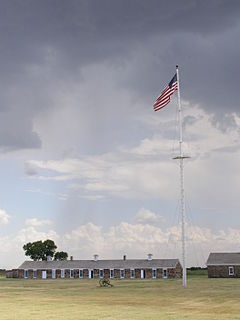
Fort Larned National Historic Site preserves Fort Larned which operated from 1859 to 1878. It is approximately 5.5 miles (8.9 km) west of Larned, Kansas, United States.
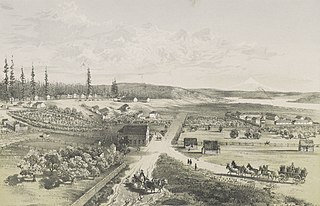
Fort Vancouver National Historic Site is a United States National Historic Site located in the states of Washington and Oregon. The National Historic Site consists of two units, one located on the site of Fort Vancouver in modern-day Vancouver, Washington; the other being the former residence of John McLoughlin in Oregon City, Oregon. The two sites were separately given national historic designation in the 1940s. The Fort Vancouver unit was designated a National Historic Site in 1961, and was combined with the McLoughlin House into a unit in 2003.

Fort Tejon in California is a former United States Army outpost which was intermittently active from June 24, 1854, until September 11, 1864. It is located in the Grapevine Canyon between the San Emigdio Mountains and Tehachapi Mountains. It is in the area of Tejon Pass along Interstate 5 in Kern County, California, the main route through the mountain ranges separating the Central Valley from the Los Angeles Basin and Southern California. The fort's location protected the San Joaquin Valley from the south and west.

Marine Barracks, Washington, D.C. is located at the corner of 8th and I Streets, Southeast in Washington, D.C. Established in 1801, it is a National Historic Landmark, the oldest post in the United States Marine Corps, the official residence of the Commandant of the Marine Corps since 1806, and main ceremonial grounds of the Corps. It is also home to the U.S. Marine Drum and Bugle Corps and the U.S. Marine Band. Barracks Marines conduct ceremonial missions in and around the National Capital Region as well as abroad. They also provide security at designated locations around Washington, D.C. as necessary, and Barracks officers are part of the White House Social Aide Program.

Canadian Forces Base Esquimalt is Canada's Pacific Coast naval base and home port to Maritime Forces Pacific and Joint Task Force Pacific Headquarters. As of 2018, 4,411 military personnel and 2,762 civilians work at CFB Esquimalt.
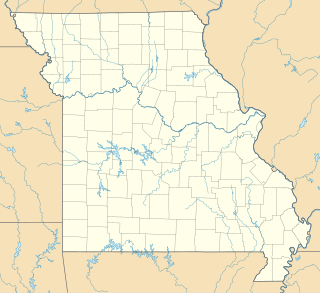
The Jefferson Barracks Military Post is located on the Mississippi River at Lemay, Missouri, south of St. Louis. It was an important and active U.S. Army installation from 1826 through 1946. It is the oldest operating U.S. military installation west of the Mississippi River, and it is now used as a base for the Army and Air National Guard. A Veterans Affairs healthcare system campus is located on the southern portion of the base and is also the headquarters for the Veterans Canteen Service.

Fagatogo is the Downtown area of Pago Pago, the territorial capital of American Samoa. It is the government, commercial, financial, and shipping center of Tutuila Island. It is also the administrative capital of American Samoa. Fagatogo is the location of the American Samoa Fono (legislature), and is listed in the Constitution of American Samoa as the territory's official seat of government. Its population is 1,737.

The Ulysses S. Grant Home in Galena, Illinois is the former home of Ulysses S. Grant, the Civil War general and later 18th President of the United States. The home was designed by William Dennison and constructed in 1859 - 1860. The home was given to Grant by residents of Galena in 1865 as thanks for his war service, and has been maintained as a memorial to Grant since 1904.
Established in 1849, the Vancouver Barracks was the first U.S. Army base located in the Pacific Northwest. Built on a rise 20 feet above the Hudson's Bay Company (HBC) trading station, Fort Vancouver. Its buildings were formed in a line adjacent to the Columbia River about 2,000 yards from the water. It is now located within modern Vancouver, Washington.

Fort Omaha, originally known as Sherman Barracks and then Omaha Barracks, is an Indian War-era United States Army supply installation. Located at 5730 North 30th Street, with the entrance at North 30th and Fort Streets in modern-day North Omaha, Nebraska, the facility is primarily occupied by Metropolitan Community College. A Navy Operational Support Center and Marine Corps Reserve unit, along with an Army Reserve unit occupy the periphery of the 82.5 acres (33.4 ha) fort. The government deeded all but four parcels of the land to the community college in 1974.

Embreeville is an historical unincorporated community, little more than a rural stretch of road with a few businesses and homes, in Newlin Township, Chester County, Pennsylvania, inside a bend of Brandywine Creek. It is about 30 miles (48 km) west of Philadelphia, and north of Unionville. The Embreeville Historic District, which covers most of the town, is on the National Register of Historic Places.
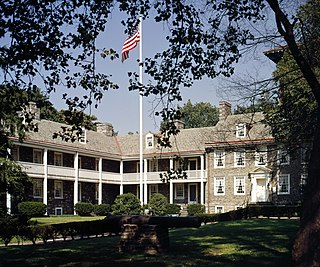
The Old Barracks Museum, also known as Old Barracks, in Trenton, Mercer County, New Jersey, United States, is the only remaining colonial barracks in New Jersey. It is the last of five such barracks authorized by the colonial legislature in 1758 to house soldiers in the French and Indian War. It housed about 300 soldiers at a time. During the American Revolution, George Washington crossed the Delaware River to catch the Hessian garrison in Trenton by surprise. Following the American Revolution, the Trenton Barracks were used as a military hospital specializing in smallpox inoculations.

Jackson Barracks is the headquarters of the Louisiana National Guard. It is located in the Lower 9th Ward of New Orleans, Louisiana. The base was established in 1834 and was originally known as New Orleans Barracks. On July 7, 1866, it was renamed in honor of Andrew Jackson. The National Register of Historic Places listed Jackson Barracks in 1976.

The "Old Stone Barracks" is the last remaining structure of a proposed quadrangle of early U.S. Army barracks built at Plattsburgh, New York in 1838. Of the four main buildings initially planned for the Plattsburgh post, only two were ever constructed, an officer's barracks and an enlisted barracks which formed an "L" shape. The buildings were utilized by the Army for nearly a Century. The officer's quarters, in which Lt. Ulysses S. Grant once stayed, was torn down by the U.S. Air Force during the winter of 1963. The remaining building, the 200-foot (61 m) long, two story "Old Stone Barracks," remained mostly empty after the early 1960s and was added to the National Register of Historic Places in 1971. In December 2010 the Barracks and more than 7 acres of property was offered to a Canadian real estate developer for $35,000 with the intention of building an apartment complex on the historic site. At the time, the Barracks property was appraised at over $775,000 and the sale sparked public outcry for its preservation. In 2014, the building was again sold to current owners Terry Schmaltz and Mary Theresa Pearl who redeveloped it as the home of the "Valcour Brewing Company." The new craft brewery is set to open early in 2016.

The Covington House historic cabin in Vancouver, Washington, was built by Richard and Charlotte "Anna" Covington born, raised and married in London, England who travelled by ship around Cape Horn/South America, stopping at the Sandwich Islands/Hawaii and finally arriving at Fort Vancouver in the Oregon Territory, where they had been hired to teach children of the Hudson's Bay Company employees. The first three "plains" of the area were held by Hudson Bay Fur Trade Co. whereas the fourth "plain" was opened up for public sale as property north of the Columbia River became part of the United States, the government gave newly acquired land to early pioneers, willing to settle and farm the land. The Covingtons taught at the Fort immediately after their arrival, 1846 until 11 April 1848 when they entered "donation land claim" No. 43 640 acres (2.6 km2) in the Fourth Plain area, the community now referred to as Orchards, Wa, where they built their home, House No. 16 and Boarding School, per the 1850 census. Although they never had any of their own children, the couple established a boarding school in addition to operating a large fruit farm, called the Kalsus Farm. The children slept in the cabin loft, as it was an arduous seven – eight-mile trek, one way, north east of the Fort and wrought with danger for small children to attempt to travel alone. The Covington's log cabin soon became known as the social center of hospitality with musical entertainment in the early days of Vancouver on the Columbia River. Besides his guitar, they also brought a violin and the first piano to the Pacific Northwest as well, they also taught music to many of these local children at that time. Richard Covington was extremely talented, in addition to building their log cabin home, and developing an expansive orchard, he served in several offices as a justice of the peace, county clerk, school superintendent, cartographer, artist, musician, vocalist, and briefly as a ranger during an "Indian uprising" First Nations/Native Americans.

Castolon, also known as La Harmonia Ranch and Campo Santa Helena, was a small community in southwestern Texas, located in what is now Big Bend National Park along the Rio Grande. The location was first settled in 1901 by Cipriano Hernandez, who farmed the area and built the original Castolon Store, now known as the Alvino House.
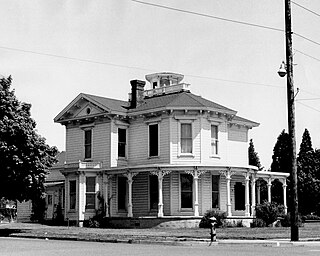
The Slocum House is a Victorian style house located in Vancouver, Washington, in the United States. The style also has been called Carpenter Victorian to emphasize both the vertical, Italianate features and the skill of craftsmanship, believed to be the work of Edward Slocum, brother of the owner. Ornamental medallions inside the house were signed and included patent dates from 1842 and 1846, although the house is believed by some to have been constructed in 1867. The 1867 date is not supported by local newspaper reports as there was no dwelling on the land at this time, and Charles W. Slocum was still busy in other areas of the Pacific Northwest. However many websites and reference books do mention the 1867 date, perhaps using a common source.




















